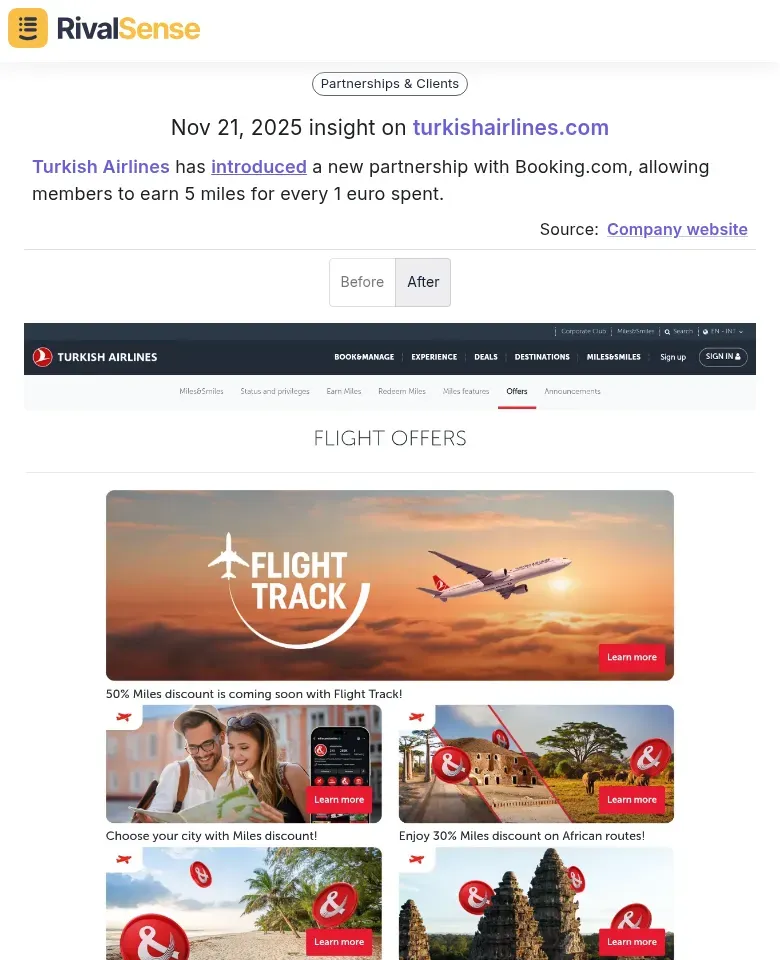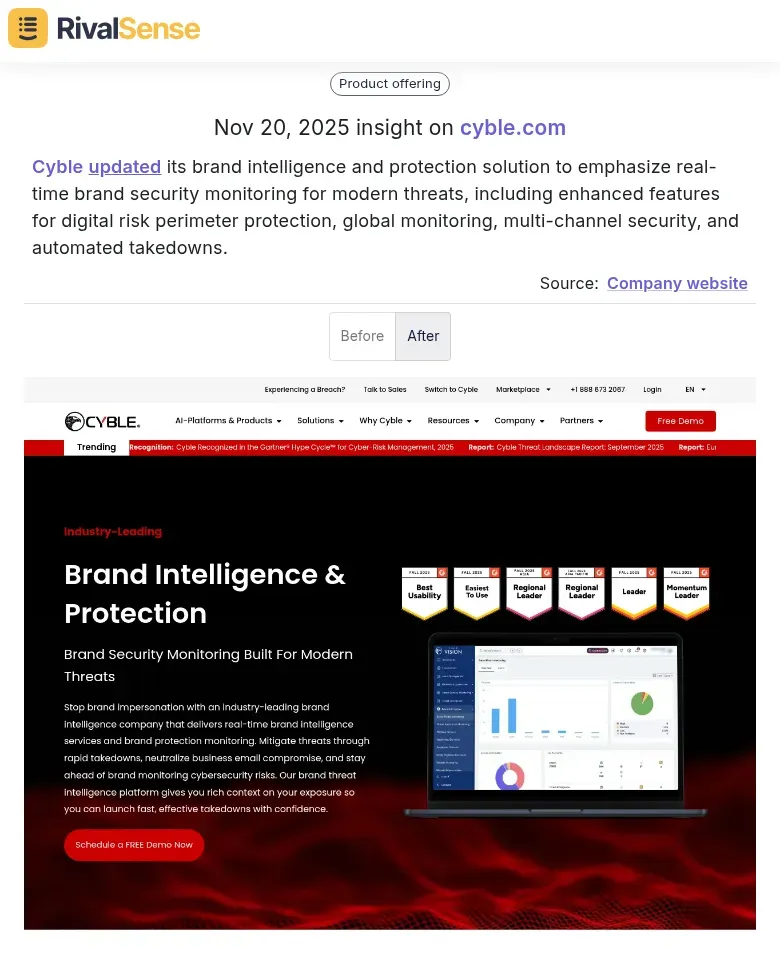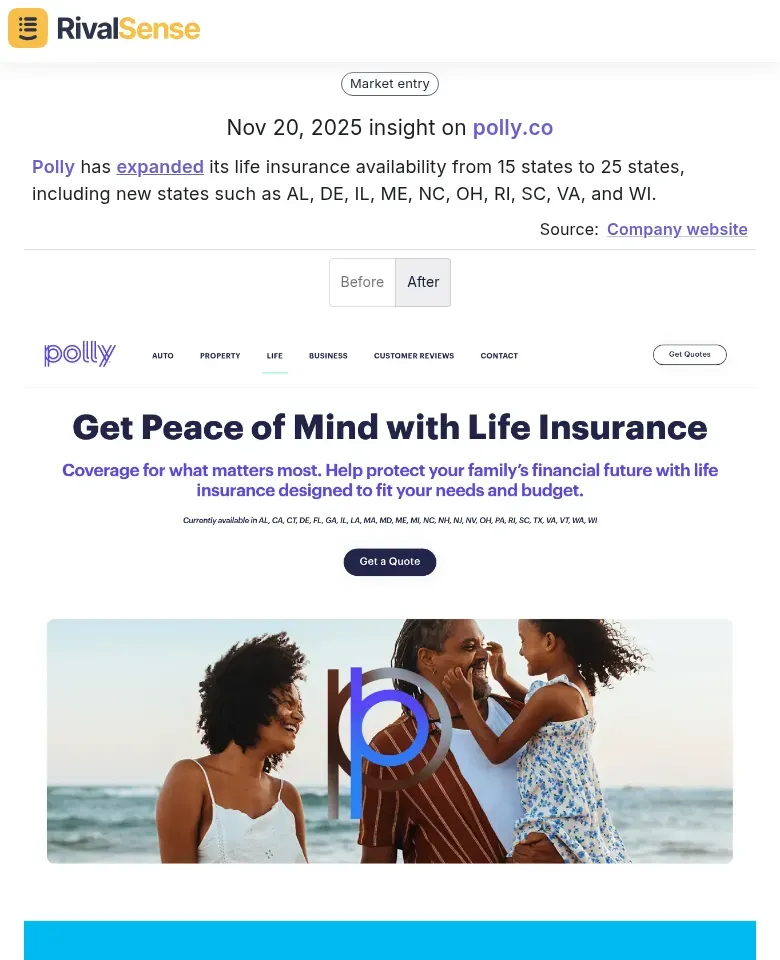How Website Changes Reveal Competitor Strategies for Key Accounts
Competitor website changes are powerful early indicators of strategic shifts that can reveal hidden business priorities. When rivals update their homepage messaging, add new case studies, or restructure service pages, they're often signaling market expansion, partnership strategies, or key account targeting. Real-time tracking of these digital footprints allows you to uncover what competitors prioritize before official announcements.
Practical steps to leverage this intelligence:
- Monitor homepage hero sections for messaging changes indicating new target markets
- Track case study additions to identify which key accounts competitors are showcasing
- Watch for new partnership logos or integration announcements signaling alliance strategies
- Set up alerts for pricing page updates that may indicate competitive positioning shifts
- Analyze navigation structure changes to understand evolving service priorities
These website updates provide actionable insights into competitor focus areas, helping you anticipate market moves and adjust your own strategy accordingly.
Partnership and Collaboration Insights from Website Updates
Website changes often reveal strategic partnerships before official announcements. By monitoring these updates, you can gain early insights into how competitors are expanding their networks and customer bases. For example, a SaaS company adding a payment processor's logo may indicate a revenue-sharing deal, highlighting potential revenue diversification strategies.
Insights into partnerships can reveal growth strategies and customer acquisition channels. RivalSense detected that Turkish Airlines introduced a new partnership with Booking.com, allowing members to earn 5 miles for every 1 euro spent.  This type of insight is valuable because it shows how companies leverage alliances to enhance loyalty programs and cross-promote services, helping you identify partnership opportunities for your own business.
This type of insight is valuable because it shows how companies leverage alliances to enhance loyalty programs and cross-promote services, helping you identify partnership opportunities for your own business.
Loyalty program integrations provide insights into customer retention strategies. Look for new points systems, tier upgrades, or partner rewards on competitor sites. If a competitor integrates with travel platforms, they're likely targeting high-value clients. Create a checklist: note integration partners, reward structures, and frequency of updates to identify retention patterns.
Promotional tie-ins highlight cross-selling and revenue diversification. Analyze limited-time offers, bundle deals, or co-marketed webinars. A competitor promoting a free tool with a partner's service suggests efforts to expand their audience. Practical tip: Set up alerts for discount codes or joint events to understand how competitors leverage partnerships for growth. Regularly review these elements to anticipate market moves and refine your own strategy.
Product and Service Evolution Through Feature Enhancements
Feature upgrades often signal how competitors respond to market threats and evolving customer demands. By tracking these enhancements, you can anticipate industry trends and adjust your product roadmap accordingly. For instance, if a rival adds real-time analytics after a new entrant launches similar tools, it's likely a defensive move to retain market share.
Monitoring product updates can highlight how competitors are adapting to emerging challenges. RivalSense insights, such as Cyble updating its brand intelligence and protection solution to emphasize real-time brand security monitoring for modern threats, including enhanced features for digital risk perimeter protection, global monitoring, multi-channel security, and automated takedowns, demonstrate the importance of staying current with feature enhancements.  This insight is valuable as it shows how companies evolve their offerings to address specific market needs, enabling you to benchmark your own innovations and identify gaps in your services.
This insight is valuable as it shows how companies evolve their offerings to address specific market needs, enabling you to benchmark your own innovations and identify gaps in your services.
Real-time capabilities indicate competitive differentiation. When competitors emphasize live dashboards or instant notifications, they're likely targeting customers who value speed. Monitor their website's messaging around 'instant' or 'live' features to gauge their strategic focus.
Automation improvements reveal operational advancements. Look for updates like automated reporting or AI-driven workflows. Benchmark these against your own processes—if a competitor automates a task you handle manually, it's a sign to innovate. Practical tip: Create a checklist to review competitor sites quarterly, noting new features, real-time claims, and efficiency gains. This helps you stay ahead by anticipating their next moves.
Geographic and Market Expansion Signals in Website Content
Website changes reveal competitor expansion strategies through geographic and market signals, providing clues about where they are investing resources. By analyzing these updates, you can identify emerging opportunities and potential competitive threats in new regions. For example, when a competitor adds Texas to their service map, they're likely targeting that market's specific industries or customer segments.
Expansion insights are crucial for understanding market penetration and scaling strategies. RivalSense reported that Polly has expanded its life insurance availability from 15 states to 25 states, including new states such as AL, DE, IL, ME, NC, OH, RI, SC, VA, and WI.  This type of insight is valuable because it reveals how companies are methodically entering new markets, allowing you to anticipate their next moves and adjust your own geographic strategy to capitalize on underserved areas or defend your position.
This type of insight is valuable because it reveals how companies are methodically entering new markets, allowing you to anticipate their next moves and adjust your own geographic strategy to capitalize on underserved areas or defend your position.
Analyze phased rollouts—starting with one region before expanding—to understand their resource allocation and risk management. This gradual approach suggests careful testing before full commitment. Track expansion patterns to anticipate moves into untapped territories; if they consistently enter markets with similar demographics, predict their next target. Practical steps:
- Use tools like RivalSense to track competitor website updates monthly
- Create a checklist of key pages (e.g., 'Locations', 'Services') to monitor for changes
- Document rollout timelines to infer strategy
- Compare patterns with your own expansion plans to stay ahead
This intelligence helps you prepare counter-strategies and identify opportunities in overlooked markets.
Actionable Intelligence: Turning Observations into Strategic Advantages
When you spot a competitor's website change, it's essential to act swiftly to transform observations into competitive advantages. By systematically analyzing these updates, you can uncover patterns that inform your strategic decisions and keep you ahead of market shifts. For example, if a rival adds integrations with popular tools, they might be targeting enterprise clients, signaling a shift in their customer focus.
Start by analyzing the pattern: Is this a one-off tweak or part of a broader strategy shift? Develop proactive counter-strategies by brainstorming 'what-if' scenarios—e.g., if they lower prices, could you emphasize superior support instead? Align your internal roadmap by benchmarking: If competitors enhance mobile usability, prioritize your own mobile updates to stay competitive. Use a checklist:
- (1) Document the change and its potential impact
- (2) Assess if it aligns with market trends
- (3) Identify gaps in your offerings
- (4) Adjust your strategy within weeks, not months
Enhance market positioning by responding swiftly; if a competitor announces a new partnership, highlight your existing alliances to reinforce trust. Tip: Set up alerts for key competitor pages to catch changes early, turning observations into strategic advantages that keep you ahead.
Leverage RivalSense for Competitive Insights
To streamline competitor monitoring and gain actionable intelligence, consider using RivalSense. It tracks competitor product launches, pricing updates, event participations, partnerships, and more, delivering weekly email reports to keep you informed. Try out RivalSense for free at https://rivalsense.co/ and get your first competitor report today to enhance your strategic decision-making.
📚 Read more
👉 Key Account Engagement Checklist for Roofing CRM Success
👉 Product Offering Competitor Analysis: Template & Framework
👉 Leveraging Competitor Executive Changes for Strategic Insights
👉 The Ultimate Guide to Key Account Management Assessment: Driving Growth Through Strategic Evaluation
👉 Case Study: Competitor Backlink Tracking Drives Strategic Vision
